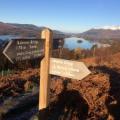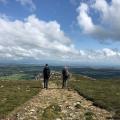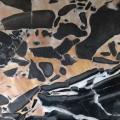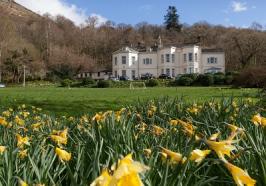News topics
Monthly Newsletters
// //// //// Online Booking //
// //// // // // // // //
For group bookings please contact
017687 77246 or
contact@derwentwater.org
Mary Pritchard, April 2019.
September 2019

This summer has been a very interesting and enjoyable one in the hostel, with new groups, such as the Rose Castle Foundation Emerging Peacemakers; some excellent wildlife, including the Purple Hairstreak butterfly; and new plans for refurbishment, to which you are warmly invited to contribute thoughts and comments.
The weather fluctuations have also been interesting, with the waterfall and lake responding very quickly to rainfall: even within a meal sitting we can see the waterfall changing shape! However, whatever the weather, we’ve noticed that more and more guests are keen to get in water, whether in tarns, lakes or streams: for instance, one regular guest, Forest Allitt, is swimming her way through all the named tarns and lakes in the Lake District and below we've included a link to her blog.
We also have articles about wildlife, the hostel refurbishment, the Heritage Open Day, a walk up Carrock Fell, and some new children’s activities at the hostel. Happy reading!

We have long been considering a refurbishment of the hostel, to provide some smaller rooms with ensuite facilities, to upgrade the toilets and showers, and to convert the large 22 bed dormitory on the first floor (Room One) into a function room open to all. As some of you may know, Room One used to be the banqueting hall when the house was built in 1787, and the ornate plasterwork on the ceiling, along with the magnificent views of Derwent Water, make it a perfect room for parties, meetings and teaching.
After a long and careful process we have now appointed a local architecture firm to develop these plans, including the rebuilding of the annex wing to create a number of 2 and 4 bedded ensuite rooms.
We have a big challenge ahead; to provide hostel facilities that are fit for purpose and meet the needs of a wide range of hostel users today, but without losing any of the unique communal spirit, atmosphere and welcome that has always made Derwentwater such a special place to stay, both in the YHA years and since becoming an independent hostel.
As we plan the refurbishment of the hostel we are keen to hear your thoughts, on both the facilities that you’d like to see provided, but also on what you love about the hostel as it is that mustn't be lost. If you would like to share your thoughts about the hostel please contact me directly by email: tim@derwentwater.org. I look forward to hearing from you.

This summer my attention has been mostly focussed on the huge variety of insects with which I'm very slowly becoming more familiar. I've had a go at identifying some of the beetles living here, and have found the uncommon Skullcap Leaf Beetle nearby, as well as large numbers of the gleaming metallic Dead-nettle Leaf Beetle and Green Dock Beetle on the lake shore.
My favourite so far though: one day while I was gawping at a morass of hoverflies near the bottom of the drive I spotted an electric blue, purple and orange spaceship-like thing sitting on a Hogweed flower. It turned out to be a huge parasitic fly named Phasi hemiptera. Looking like the painstakingly airbrushed cover illustration of a 1980s sci-fi novel, this evil miniature mechanoid apparently lays its eggs on other insects, mainly Shieldbugs. Its young, having hatched into the body of the living Shieldbug, then proceed to devour it from the inside out. How quaint.
Whilst serving breakfasts one morning I noticed a tiny butterfly perched on the glass of the servery window opposite me. Having some idea of what it might be I nearly splurted out my coffee, threw a plateful of beans and sausage all down the front of the nearest guest and screamed "Purple Hairstreak!" It was a very rare sighting as Purple Hairstreaks sensibly spend most of their time hiding from people up in the tops of oak trees. Sadly it vanished while I was climbing onto the window ledge outside to take a photo.
There have also been lots of different butterflies in the meadow this summer. It was exciting to see a Small Pearl-bordered Fritillary in the grounds for the first time, followed by the usual Dark Green Fritillaries that visit each year. Other species included Large Skipper, Small Skipper, Ringlet, Small Copper and Painted Lady. Also during one particular week this August if you'd stared into the purple blaze of Knapweed on the left of the drive as you approached the hostel, your gaze would have been met by the glaring eyes of dozens of Peacock butterflies.
The most notable moth of the last couple of months has been the Barred Carpet, which is nationally scarce although Cumbria is one of the strongholds of this species in the UK. It may not really look like anything special, but it is.
Alongside all the insects, there have been fantastic displays of wildflowers in the meadow and on the lake shore this summer, the colours changing subtly as the weeks go by. There are too many to list and a lot that I still don't know, but off the top of my head I remember having seen Yellow Rattle, Birdsfoot Trefoil, Betony, Selfheal, Meadow Vetchling, Knapweed, Hedge Woundwort, Marsh Woundwort, Tufted Vetch, Great Burnet and Meadowsweet.
Birdwise there have been some excellent views of Peregrine Falcons around the nearby crags and one of our guests said she saw an Osprey flying over Derwent Water while she was standing on the terrace. One or two afternoons of patient standing around in the woods have also been rewarded by glimpses of Redstarts, Wood Warblers and Pied Flycatchers. Around the bird feeders the usually shy Jays and Stock Doves have been making more regular appearances, as well as Great Spotted Woodpeckers, Nuthatches and various Tits and Finches. I haven't noticed any unusual birds on the lake recently but Pez has spotted a Little Egret a couple of times in the last few weeks.
The Red Squirrels continue to visit the feeders, although we have had several sightings of Grey Squirrels as well in the last few months. A couple of us have been lucky enough to see Foxes while we've been out and about, including one that I startled among the trees near the car park early one morning. Tim and Dusty (Tim’s dog) also frequently find evidence of Badgers nearby. There have been a few Red Deer with young knocking about on the fells above the hostel and the other day Matthew noticed Roe Deer in the woodland outside the dining room windows.
Do let us know if you’d like to share any of your wildlife encounters, sightings or photos from your stay at the hostel – it is always good to know what you have seen and experienced, from ferns to falcons, or maybe even butterflies at breakfast.

Every now and then Forest visits the hostel, with float in tow and Archibald the thermometer duck not far behind. Then she disappears for several hours, reappears glowing or exhausted, and a short while later pops up in our inbox, with an underwater selfie and an exciting new blog post.
There will be lots more blog posts to follow as Forest still has about 80 lakes and tarns to swim across, having set herself the challenge of swimming across every Ordnance Survey Map-named tarn and lake in the Lake District. Good luck Forest!
Here is the link to her blog: https://swimmingthelakes.com/

Throughout the summer we have been exploring the quieter corners of Borrowdale and the North Lakes, seeking peace and solitude during the busiest time of year. One such area is Carrock Fell, and in mid-August I had the chance for a short walk to it's summit from Stone Ends, a route I’d now highly recommend.
A 30 minute drive from the hostel takes you via Keswick and Mungrisedale out onto the Fell Road just north of the tiny hamlet of Mosedale, with roadside parking below the steep, craggy eastern slopes of Carrock Fell.
Starting out in thick mist and the remains of overnight rain, the clouds burned off as the slope eased, giving us surprise views southwards of the Skiddaw and Blencathra range. Whilst we were more focussed on reaching the summit and exploring the hill fort, I couldn’t help noticing that the 1:25,000 map shows features such as ‘Apronful of Stones’, ‘Scurth’ and ‘The Trough’ on the hillside, giving a pretty good indication of the steep stony climb, as well as it's popularity for bouldering on the lower slopes. There is no doubt about the summit: it boasts a huge recently rebuilt cairn!
The picture above sums up that day, and the reason I walk the Lakeland Hills: a surprise view, tranquillity, and the company of good friends on the hills I love.

What is this a photo of? In what year did the Queen visit the hostel? Can you find a Yew tree in the hostel grounds? Which island on Derwent Water features in The Tale of Squirrel Nutkin?
You can explore these questions and find out more about the hostel and local area by doing our self-led trails and quiz. Extra points for doing them all! Our existing activities include an orienteering course and a red squirrel trail, but we now have an image hunt, a quiz, and a tree trail, thanks to the help of our wonderful volunteer, Sandra. All of the activities can be done independently, at any time. Please just ask at reception for a copy of the activity you'd like to do. As a reward for trying the trails, you can then make a badge - how will you design yours?!





